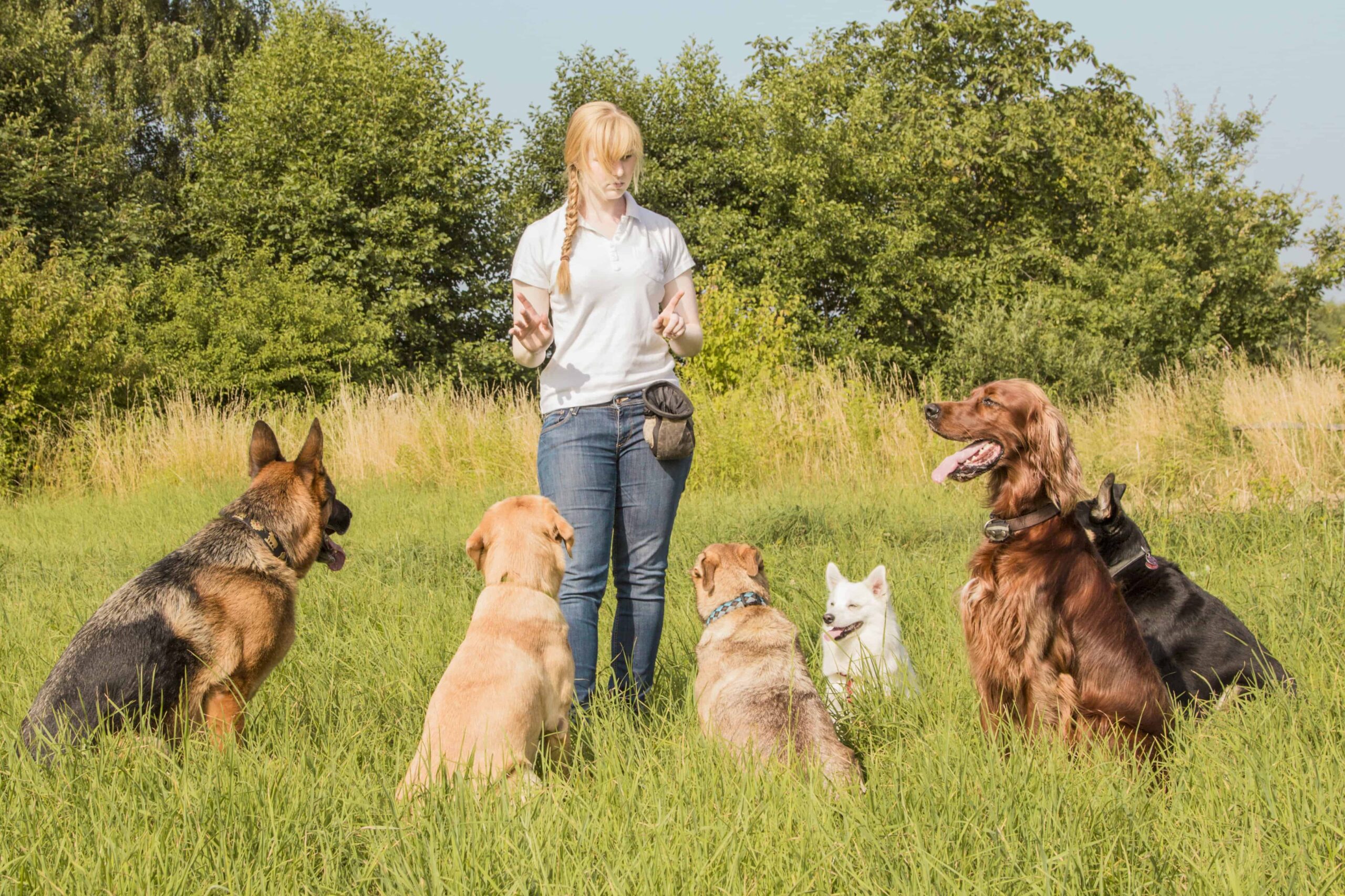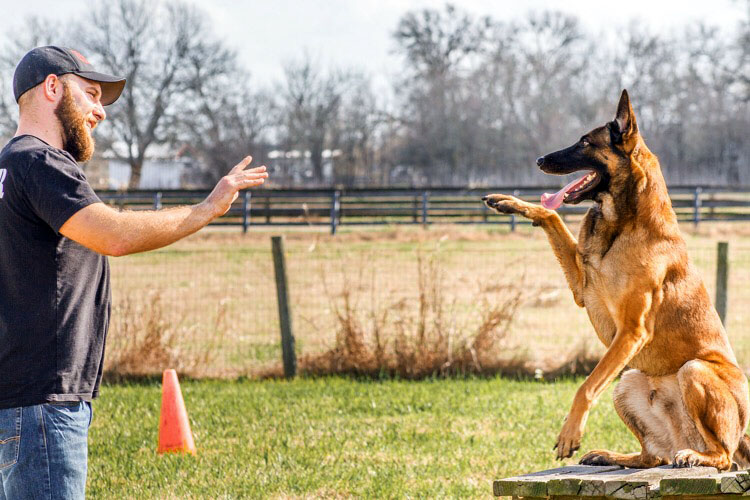Important Tips for Effective Dog Training: An Overview for Family Pet Owners
Efficient pet dog training is a complex process that calls for a tactical approach tailored to both the animal's character and the proprietor's purposes. Understanding exactly how to browse these challenges can significantly boost the training experience, eventually transforming the partnership between proprietor and dog.
Recognizing Canine Behavior
Understanding pet dog actions is vital for reliable training and cultivating an unified connection in between pooches and their proprietors. dog training. Dogs interact mostly through body language, vocalizations, and actions, making it vital for proprietors to interpret these signals accurately.

Socializing plays a significant duty in pet actions; direct exposure to numerous atmospheres, individuals, and various other pets can dramatically influence a dog's temperament. Factors such as type features and private temperament should assist training techniques, as some breeds might have particular behavior qualities that necessitate customized techniques. By understanding these components, owners can develop a helpful atmosphere that encourages favorable habits, leading to effective training results and a deeper bond with their pet dogs.
Establishing Constant Commands
Effective communication with your canine begins with developing regular commands. This fundamental component of training is essential for fostering understanding in between you and your pet. Consistency in the commands you make use of guarantees that your pet can dependably link details words or phrases with the wanted behaviors.
When picking commands, select clear, distinct words that are very easy to state and set apart from each other. Stay clear of using similar-sounding commands that might confuse your canine. Using "sit" and "remain" is ideal, but "rest" and "struck" might lead to misunderstandings.
In addition, keep the very same tone and volume for each command. Pet dogs are sensitive to singing signs, so differing your tone can develop confusion.
It is just as vital to make certain that all relative are on the same web page relating to the commands utilized. A united front in command usage will certainly stop blended signals and reinforce the learning process.
Favorable Reinforcement Techniques
The power of favorable support in pet dog training hinges on its capacity to motivate desired behaviors via benefits and praise. This technique is based in the principle that actions complied with by beneficial outcomes are extra most likely to be repeated. By incorporating favorable reinforcement right into your training regimen, you can properly shape your pet's habits in a constructive way.
To implement favorable reinforcement, it's necessary to recognize what motivates your pet, whether it be deals with, toys, or spoken praise. When your pet does a desired activity, such as resting on command, promptly reward them with a reward or affection. This organization in between the command and the favorable result strengthens their understanding.
It's critical to timing the incentives properly; providing the reinforcement within secs of the preferred behavior aids your dog make the connection (dog training). In addition, uniformity is crucial-- make sure that all member of the family make use of the same commands and benefit systems to avoid complication

Gradually, you can minimize the regularity of deals with as your dog discovers the habits, transitioning to commend or intermittent benefits. This technique not just cultivates a solid bond between you and your canine however additionally promotes a special info positive discovering setting, making training a delightful experience for both.
Socialization and Interaction
Regularly revealing your pet to a variety of atmospheres, Bonuses individuals, and various other animals is important for their social advancement. Socializing must start early, preferably throughout the crucial window of 3 to 14 weeks, when young puppies are most receptive to new experiences. Older pet dogs can likewise benefit from ongoing socialization initiatives.
Present your pet to various settings, such as parks, pet-friendly stores, and urban locations. This direct exposure assists them adapt to various stimulations, reducing anxiety and anxiety feedbacks. Urge positive interactions with various other pet dogs and people, making sure that these encounters are safe and regulated to foster confidence.
Utilize organized playdates with genteel canines, as this can enhance your pet's social abilities and instruct them proper actions. Obedience courses and training sessions likewise supply exceptional possibilities for socializing, allowing your dog to engage with others in a supervised atmosphere.
Monitor your pet dog's body movement during communications, as this will assist you gauge their convenience degree. Gradually raise direct exposure to more tough circumstances while ensuring that each experience declares. A well-socialized dog is more probable to display well balanced behavior, making them a happiness to have in any kind of setup.
Addressing Typical Training Obstacles
Every canine proprietor will run into training difficulties at some time, despite their pet's age or socializing level. Recognizing typical concerns such as stubbornness, distractions, and fearfulness can assist in creating effective techniques for enhancement.

Interruptions during training sessions can hinder emphasis. To fight this, start training in a peaceful atmosphere with minimal stimulations. Slowly present disturbances as the pet comes to be extra skilled in commands. Short, regular training sessions are likewise efficient in preserving interest.
Fearfulness can hinder a dog's learning procedure. Progressive desensitization to the source of fear, paired with favorable reinforcement, can help alleviate anxiousness. Perseverance is important; never force a pet into a situation that creates distress, as this might intensify the issue.
Ultimately, understanding and resolving these typical obstacles with an organized technique will cultivate a much more productive training experience, reinforcing the bond between dog and proprietor while promoting efficient learning.
Verdict
In summary, effective canine training relies on a detailed understanding of canine habits, the establishment of consistent commands, and the application of positive support methods. Socializing plays a critical function in creating well-adjusted animals, while resolving common training obstacles requires persistence and flexibility. By executing these crucial techniques, pet dog owners can promote a solid bond with their dogs and promote preferable behaviors, eventually bring about a harmonious connection in between humans and their canine buddies.
Recognizing dog habits is crucial for effective training and promoting an unified relationship between dogs and their proprietors.Socialization plays a considerable role in pet dog habits; direct exposure to different environments, individuals, and various other animals can significantly affect a dog's character.The power of positive support in pet training lies in its ability to urge wanted actions via rewards and praise. By incorporating positive reinforcement into your training program, you can properly form your pet's actions in a positive fashion.
In recap, effective pet training counts on a thorough understanding of canine actions, the facility of constant commands, and the application of favorable reinforcement methods.
Comments on “Understanding Canine Body Movement Throughout Dog Training”